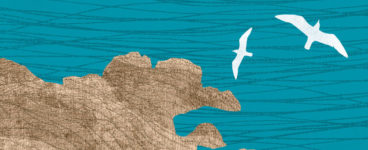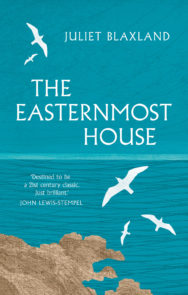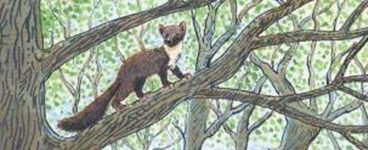‘Birds often cited as rare or endangered, particularly hen harriers, lapwings and curlews, are living quite happily here, untagged, unwatched, unseen by anyone, except occasionally by me and three ducks.’
This issue has been concentrating a lot on the the feeling of wellbeing connected with the cycles of change in our nature and landscape. We can’t help it! There are so many great books that remind us of the importance of paying thoughtful attention to the world around us. Juliet Blaxland has been paying attention to the land around her in the easternmost part of England, only 25 paces away from the cliff edge.
Extract taken from The Easternmost House
By Juliet Blaxland
Published by Sandstone Press
‘Oh, to be in England, now that April’s there, for whoever wakes in England sees, some morning, unaware, that the lowest boughs of the brushwood sheaf the elm tree bowl are in tiny leaf, while the chaffinch sings in the orchard bough, in England – now!’ One of the earliest poems I learnt as a punishment for talking after lights-out at boarding school, was Home Thoughts from Abroad, by Robert Browning. At that time, it was one of my favourite poems (another being the ‘Stop all the clocks’ one made famous in Four Weddings and a Funeral, which I also learnt as a ‘punishment’). Now, reading the April poem aloud as fluent normal English without the line breaks (as above, and in the game of ‘Crit that Poet’), it niggles me that Robert Browning has used the word ‘bough/s’ twice in the same sentence and has ended the poem with a gratuitously unnecessary screamer!
Yet the April poem and its sentiment still evokes in me a nostalgia for certain ‘old friends’ who have died, old friends who happened to be trees: a particular weeping lime felled by the 1987 storm, our lost orchards, an old chestnut. The weeping lime I planted as a teenager, mourning the many losses in the storm, is now thriving and tall. I remember feeling guilty for minding more about the weeping lime than some person who had recently died at the time. I find it comforting to think how many long-lived trees I have personally planted during my brief moment of life, like the wise man of the aphorism, who plants trees in whose shade he will never sit.
Browning’s poem also stirs a more general appreciation of our native trees, particularly the English elm, many an ‘elm tree bowl’ savaged by Dutch Elm Disease, approximately when we were toddlers. It reminds us of our symbiotic relationship with wood and timber, the ‘if we nurture trees, they will nurture us’ kind of idea, and how cut timber is so obviously useful. More of which later.
As well as brushwood sheaf in tiny leaf and the Grand National (by far the most exciting day of the year for me when aged ten), April on our clifftop also brings the ‘stringing of the beach’, which involves the stringing-off of a section of shingle for the ground-nesting birds. Avocets, oystercatchers and ringed plovers nest there undisturbed, by the calm water of Easton Broad, which is also visited by bitterns, geese, mallards and swans.
There is a movement in the birdwatching world, a world with which I am largely unfamiliar (despite watching birds most days) promoting birdwatching as beneficial to mental health. Although mental health is a currently fashionable subject, my hunch is that mental health problems have always been with us and always will be, and not everyone can stiff-upper-lip their way through it, so anything that helps people deal with their troubles can only be a good thing. And watching birds certainly can.
I hesitate to use the word ‘birdwatching’, as it leads into ‘birding’ and then ‘twitching’ and phrases like ‘showing well’, which can become mildly obsessive, even to the point of aggression. I know this because I have several times met unexpected birders in our so-called garden, looking into the hedge from the garden side not the crop side (which is also private land) for a tree sparrow or some other little brown job they have been alerted to by Rare Bird Alert on the internet. The birders were enthusiastic and chatty, but apart from trespassing, which people are perfectly free to do, it seems slightly bad manners to actually go into someone’s garden without asking. The ‘right to roam’ applies to uncultivated mountain and moorland, not the gardens of Suffolk. Serious birding also seems to miss some of the point.
Concentrating on quantifying rather than qualifying birds, ticking-off rather than just enjoying watching the birds for their own sake, seems to create extra stress rather than calming it. It strays into avian trainspotting. Will the bird ‘show well’? Can we flush the bird? Why are we not allowed on this private land? And all of this in a big crowd of people with long lenses. The now infamous ‘PG Tips twitch’ at Holkham is a fine example of the genre, immortalised on YouTube.
Birds often cited as rare or endangered, particularly hen harriers, lapwings and curlews, are living quite happily here, untagged, unwatched, unseen by anyone, except occasionally by me and three ducks. Reed buntings are regulars in our garden. Sand martins live in deep holes in the cliff. Swooping swallows and sand martins seem to lose some of their freedom when referred to as ‘hirundines’, and a swift is a swift is a swift. Birdwatching somehow seems more stressful than simply watching birds.
The Easternmost House by Juliet Blaxland is published by Sandstone Press, priced £9.99
ALSO IN THIS ISSUE

 The Easternmost House
The Easternmost House
‘Birds often cited as rare or endangered, particularly hen harriers, lapwings and curlews, are livin …














